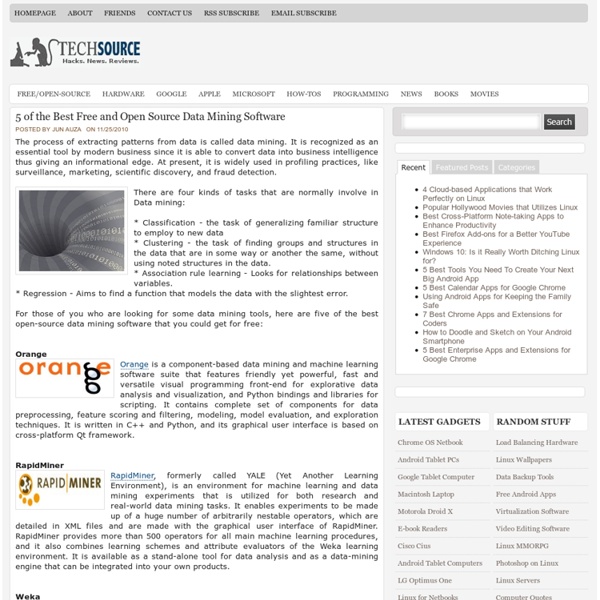Data Mining
Image: Detail of sliced visualization of thirty video samples of Downfall remixes. See actual visualization below. As part of my post doctoral research for The Department of Information Science and Media Studies at the University of Bergen, Norway, I am using cultural analytics techniques to analyze YouTube video remixes. My research is done in collaboration with the Software Studies Lab at the University of California, San Diego. A big thank you to CRCA at Calit2 for providing a space for daily work during my stays in San Diego. The following is an excerpt from an upcoming paper titled, “Modular Complexity and Remix: The Collapse of Time and Space into Search,” to be published in the peer review journal AnthroVision, Vol 1.1.
CourseWiki - CS448B Data Visualization
The world is awash with increasing amounts of data, and we must keep afloat with our relatively constant perceptual and cognitive abilities. Visualization provides one means of combating information overload, as a well-designed visual encoding can supplant cognitive calculations with simpler perceptual inferences and improve comprehension, memory, and decision making. Furthermore, visual representations may help engage more diverse audiences in the process of analytic thinking.
Eureqa
Eureqa is a breakthrough technology that uncovers the intrinsic relationships hidden within complex data. Traditional machine learning techniques like neural networks and regression trees are capable tools for prediction, but become impractical when "solving the problem" involves understanding how you arrive at the answer. Eureqa uses a breakthrough machine learning technique called Symbolic Regression to unravel the intrinsic relationships in data and explain them as simple math.
UsefulResources - CS448B Data Visualization
If you have an interesting visualization tool, resource, blog or announcement that you would like to share with the class please post them here for everyone to see. Interesting Visualizations Video Blogs
FlowStone
FlowStone uses a combination of graphical and text based programming. Applications are programmed by linking together functional building blocks called components. Events and data then flow between the links as the application executes. All this happens instantly - there's no compiling, your application runs as you build it making development an extremely rapid process. FlowStone allows you to create your own components using Ruby. This is a very modern language that is incredibly easy to pick up.
What Jobs Are There in Data Visualization?
I got an email from Harald asking, "How does the job market for DV developers work?" I find this question, or some variation of it, in my inbox every now and then, so I thought I'd give it a shot. I am after all a graduate student who will graduate eventually, so let's take a look at some of the options. I'd like to expand on the question though, and not just focus on developers. What's the job market like for anyone who wants to do data visualization for a living?
Protei
>> 2013/04/25, 08:00 : Barcelona, Spain>> 2013/04/18, 08:00 - April 21, 20:00 : Casablanca, Morroco>> 2012/04/06, 08:00 - April 10, 20:00 Tema (Accra), Ghana>> 2013/03/25, 08:00 - March 30, 20:00 : CAPE TOWN, SOUTH AFRICA>> 2013/03/08, 08:00 - March 18, 20:00 : Port Louis, Mauritanie>> 2013/03/06 08:00 - March 11, 20:00 : Cochin, India>> 2013/03/01, 20:00 - Feb 25, 08:00 : Rangoon, Burma>> 2013/02/20, 08:00 - Feb 21, 20:00 : Singapore>> 2013/02/12, 08:00 - February 18, 16:00 : Ho Chi Minh, Vietnam>> 2013/02/07, 08:00 - Feb 8, 20:00 : Hong Kong>> 2013/02/03 : 08:00 - Feb 4, 20:00 : Shanghai, China>> 2013/01/30, 08:00 - Jan 31, 20:00 : Kobe, Japan>> 2013/01/27, 08:00 - Jan 28, 23:00 : Yokohama, Japan >> 2013/01/15, 08:00 - 16, 20:00 : Hilo, Hawaii, USA>> 2013/01/9, 17:00 : departure from San Diego, CA, USA >> 2012/11/29 : TEDxVilaMada "Nosso Planeta Agua" Sao Paolo, Brasil >> 2012/10/18 - 28 : Protei at Lodz Design Festival, Poland. Blog
The Year In Data
Owni’s data team – collectively known as Paule d’Atha – are pleased to present a selection of the best of the best of their weekly round-up of data on the web, from a year that’s seen so many wonderful, innovative, inventive, colorful, moving and funny projects. The future is on the cards The World of Seven Billion is a project powered by National Geographic to celebrate the arrival of the seven billionth person on Earth. The contrast between the black background and the bright colors used to represent different income levels, coupled with population density, across all five continents gives the map a beautiful clarity. Using public data from the World Bank, it also presents current indicators of public health, education, fertility and access to technology in its effective no-frills style.
The Spy Files
2. Act normal If you are a high-risk source, avoid saying anything or doing anything after submitting which might promote suspicion. In particular, you should try to stick to your normal routine and behaviour.
Workshops
Are you an artist looking to explore digital media? Are you a web developer wanting to learn new skills, and new tools? Do you want to create using computers? In my studio in Brooklyn, I lead small-group workshops exploring various topics including Processing, data visualization, generative practices, and tangible computing. With a maximum class-size of 10 , these workshops allow for plenty of one-on-one instruction, as well as dialogue and discussion between all attendees. These sessions provide an excellent opportunity to learn new skills and to explore new ideas in a comfortable environment.
GGobi data visualization system.
D3.js - Data-Driven Documents
Graphviz



